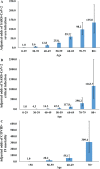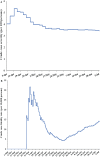Characterizing the Qatar advanced-phase SARS-CoV-2 epidemic
- PMID: 33737535
- PMCID: PMC7973743
- DOI: 10.1038/s41598-021-85428-7
Characterizing the Qatar advanced-phase SARS-CoV-2 epidemic
Abstract
The overarching objective of this study was to provide the descriptive epidemiology of the severe acute respiratory syndrome coronavirus 2 (SARS-CoV-2) epidemic in Qatar by addressing specific research questions through a series of national epidemiologic studies. Sources of data were the centralized and standardized national databases for SARS-CoV-2 infection. By July 10, 2020, 397,577 individuals had been tested for SARS-CoV-2 using polymerase-chain-reaction (PCR), of whom 110,986 were positive, a positivity cumulative rate of 27.9% (95% CI 27.8-28.1%). As of July 5, case severity rate, based on World Health Organization (WHO) severity classification, was 3.4% and case fatality rate was 1.4 per 1,000 persons. Age was by far the strongest predictor of severe, critical, or fatal infection. PCR positivity of nasopharyngeal/oropharyngeal swabs in a national community survey (May 6-7) including 1,307 participants was 14.9% (95% CI 11.5-19.0%); 58.5% of those testing positive were asymptomatic. Across 448 ad-hoc testing campaigns in workplaces and residential areas including 26,715 individuals, pooled mean PCR positivity was 15.6% (95% CI 13.7-17.7%). SARS-CoV-2 antibody prevalence was 24.0% (95% CI 23.3-24.6%) in 32,970 residual clinical blood specimens. Antibody prevalence was only 47.3% (95% CI 46.2-48.5%) in those who had at least one PCR positive result, but 91.3% (95% CI 89.5-92.9%) among those who were PCR positive > 3 weeks before serology testing. Qatar has experienced a large SARS-CoV-2 epidemic that is rapidly declining, apparently due to growing immunity levels in the population.
Conflict of interest statement
The authors declare no competing interests.
Figures



Similar articles
-
Antibody response using six different serological assays in a completely PCR-tested community after a coronavirus disease 2019 outbreak-the CoNAN study.Clin Microbiol Infect. 2021 Mar;27(3):470.e1-470.e9. doi: 10.1016/j.cmi.2020.11.009. Epub 2020 Nov 20. Clin Microbiol Infect. 2021. PMID: 33221432 Free PMC article.
-
A cross-sectional community-based observational study of asymptomatic SARS-CoV-2 prevalence in the greater Indianapolis area.J Med Virol. 2020 Nov;92(11):2874-2879. doi: 10.1002/jmv.26182. Epub 2020 Jul 2. J Med Virol. 2020. PMID: 32543722 Free PMC article.
-
Follow-up of SARS-CoV-2 positive subgroup from the Asymptomatic novel CORonavirus iNFection study.J Med Virol. 2021 May;93(5):2925-2931. doi: 10.1002/jmv.26810. Epub 2021 Feb 1. J Med Virol. 2021. PMID: 33463731 Free PMC article.
-
The Proportion of SARS-CoV-2 Infections That Are Asymptomatic : A Systematic Review.Ann Intern Med. 2021 May;174(5):655-662. doi: 10.7326/M20-6976. Epub 2021 Jan 22. Ann Intern Med. 2021. PMID: 33481642 Free PMC article.
-
Global Percentage of Asymptomatic SARS-CoV-2 Infections Among the Tested Population and Individuals With Confirmed COVID-19 Diagnosis: A Systematic Review and Meta-analysis.JAMA Netw Open. 2021 Dec 1;4(12):e2137257. doi: 10.1001/jamanetworkopen.2021.37257. JAMA Netw Open. 2021. PMID: 34905008 Free PMC article.
Cited by
-
Assessing the performance of a serological point-of-care test in measuring detectable antibodies against SARS-CoV-2.PLoS One. 2022 Jan 31;17(1):e0262897. doi: 10.1371/journal.pone.0262897. eCollection 2022. PLoS One. 2022. PMID: 35100295 Free PMC article.
-
History of primary-series and booster vaccination and protection against Omicron reinfection.Sci Adv. 2023 Oct 6;9(40):eadh0761. doi: 10.1126/sciadv.adh0761. Epub 2023 Oct 4. Sci Adv. 2023. PMID: 37792951 Free PMC article.
-
SARS-CoV-2 Infection Is at Herd Immunity in the Majority Segment of the Population of Qatar.Open Forum Infect Dis. 2021 May 2;8(8):ofab221. doi: 10.1093/ofid/ofab221. eCollection 2021 Aug. Open Forum Infect Dis. 2021. PMID: 34458388 Free PMC article.
-
BNT162b2 Versus mRNA-1273 Vaccines: Comparative Analysis of Long-Term Protection Against SARS-CoV-2 Infection and Severe COVID-19 in Qatar.Influenza Other Respir Viruses. 2024 Oct;18(10):e13357. doi: 10.1111/irv.13357. Influenza Other Respir Viruses. 2024. PMID: 39343986 Free PMC article.
-
Application of human RNase P normalization for the realistic estimation of SARS-CoV-2 viral load in wastewater: A perspective from Qatar wastewater surveillance.Environ Technol Innov. 2022 Aug;27:102775. doi: 10.1016/j.eti.2022.102775. Epub 2022 Jun 22. Environ Technol Innov. 2022. PMID: 35761926 Free PMC article.
References
-
- Lacina L. WHO coronavirus briefing: Isolation, testing and tracing comprise the 'backbone' of response. Available from: https://www.weforum.org/agenda/2020/03/testing-tracing-backbone-who-coro.... Accessed on: April 27, 2020. World Economic Forum (2020).
-
- Ministry of Public Health-State of Qatar. Coronavirus Disease 2019 (COVID-19). Available from: https://covid19.moph.gov.qa/EN/Pages/default.aspx. Accessed on: January 27, 2021 (2021).
-
- World Health Organization. International guidelines for certification and classification (coding) of COVID-19 as cause of death. Available from: https://www.who.int/classifications/icd/Guidelines_Cause_of_Death_COVID-.... Document Number: WHO/HQ/DDI/DNA/CAT. Accessed on June 1, 2020 (2020).
-
- Planning and Statistics Authority- State of Qatar. Qatar Monthly Statistics. Available from: https://www.psa.gov.qa/en/pages/default.aspx. Accessed on: May 26, 2020 (2020).
-
- Planning and Statistics Authority-State of Qatar. The Simplified Census of Population, Housing & Establishments. Available from: https://www.psa.gov.qa/en/statistics/Statistical%20Releases/Population/P... Accessed on: April 2, 2020 (2019).
Publication types
MeSH terms
Grants and funding
LinkOut - more resources
Full Text Sources
Other Literature Sources
Medical
Research Materials
Miscellaneous

